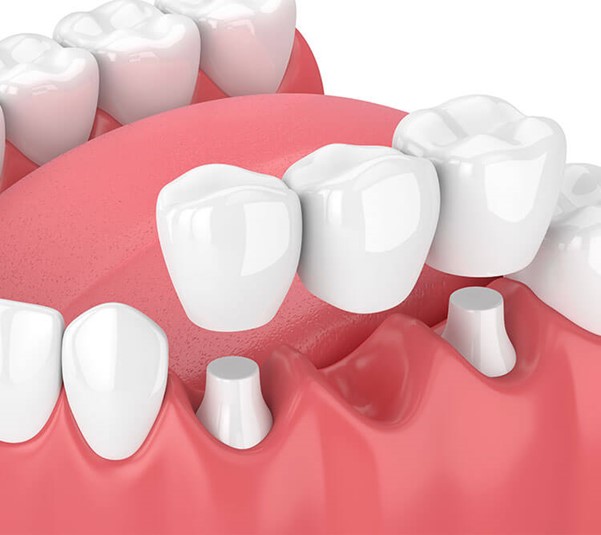Cosmetic Dental Services
Dental Bridge
Sometimes, tooth decay or trauma can result in the loss of a tooth or multiple teeth. If you are missing one or more teeth, a dental bridge might be just what you need.
A dental bridge replaces a missing tooth with an artificial tooth. It is held in place by two porcelain crowns. The dental bridge fills the gap where a tooth or teeth are missing. They are essentially false teeth held in place by utilising the surrounding teeth.
Dental crowns cap the two existing natural teeth that are on either side of the gap. These teeth are referred to as the abutment teeth. Once fused together the dental crowns hold the artificial tooth in place, making it appear as if there is no missing tooth.
Dental bridges are a common dental restorative solution – they are safe, long term and a cost-effective solution to replacing your missing teeth.

Types of Bridges
Traditional bridge - the false tooth is held between two crowns that are cemented on the surrounding natural teeth. This method requires one natural tooth on each side of the gap to hold the false tooth in place.
Cantilever bridge - the false tooth is held in place by having the dental crown cemented on only one of the surrounding natural teeth. This contrasts the traditional bridge, which needs 2 natural teeth to be cemented with the crowns to hold the false tooth in place.
Maryland bridge - this method is similar to the traditional bridge in which there is a requirement for 1 or 2 crowns fused in the two surrounding natural teeth. However, where it differed is that this technique does not use crowns but instead employs metal or porcelain frame that bond to the back of surrounding natural teeth.
Dental Implant supported bridge - unlike the traditional , cantilever or Maryland bridges that require the support of the surrounding natural teeth, it is possible to have a bridge where the fake tooth is supported by dental implants. This method needs you to have implants embedded in the jawbone first and then in a separate procedure the dental bridge is fitted.
Should I have a dental bridge?
There are a number of factors to consider whether a bridge is the right treatment for you. This includes:
- you don't like the look of having a missing tooth. It is making you feel self conscious or even embarrassed
- you are finding it difficult to chew or bite
- there is a greater risk of tooth decay and gum disease caused by the gap arising from the absent tooth. This can lead to the surrounding teeth drifting and tilting into the vacant space. This creates more gaps between teeth and increased incidence of food impaction and plaque collection.
- difficulty to control plaque and an increased risk of caries and tooth decay of the remaining teeth. Ultimately, this may mean more tooth loss.
- experiencing jaw issues (TMJ) if your occlusion (bite) has been compromised.
- a gap can lead to a change in facial appearance and speech.
- dental bridges cost
Other considerations that the dentist will consider include your general oral health and risk factors .
A dental bridge is useful in the following situations:
- Fill gaps left from missing teeth
- To improve your smile and confidence
- Help restore proper chewing
- Where partial dentures are not working
- Restore ability to talk naturally
- Prevent adjacent teeth moving and causing other dental issues
- You have fractured fillings
A bridge is a great solution if you don’t want to undergo intrusive or expensive surgery for an implant.
It’s also an option where teeth on either side of the missing tooth are defective in shape or size, or already subject to treatment. And it is safe to have a bridge span the length of up to 5 missing teeth, which makes it a great alternative to an implant or denture.
Unlike dentures, a dental bridge does not need removal each day.
They are fixed and permanent, and custom made to blend with your existing tooth shape and colour. In fact, it is often difficult to distinguish between natural and the artificial teeth of your bridge.
Dental bridges are long lasting with the right care. The best way to ensure your bridge lasts is to keep your teeth clean and maintain good oral hygiene.
Regular brushing and flossing at home can help preserve your bridge.
At your regular check-up your bridge will be reviewed for any wear and tear, and together with professional cleanings you can keep your bridge in tip top condition.
Risk Factors To Consider
There are a number of risk factors that should be considered when deciding if a dental bridge is right for you. The success and longevity of your bridge may depend on:
- the bridge design and materials chosen to make your bridge. For instance, the expanse of your bridge and number of teeth involved means more room for failure of the bridge.
- how well you look after your bridge – considering your oral hygiene practices, biting and chewing
- the dental lab and technicians involved in constructing the bridge and the experience of the dentist procuring and fitting the device
- your surrounding supporting natural teeth and gums – if these are compromised (e.g. due to decay and caries, gum disease and trauma) this places the bridge in it entirety under risk of failure.
Caring For Your Dental Bridge
A bridge can last 10 – 15 years and in some cases even 20 years. The longevity and success of your bridge is determined on various factors including how well you look after it. Watch what you eat and make sure you eat and make sure you maintain good oral hygiene practices including brushing and flossing regularly.
A dental bridge can also help improve your bite and improve speech.
You can even have a temporary bridge until your permanent bridge is ready. This is often done when waiting for the gum to heel after a tooth extraction.

Are You Ready to Restore that Amazing Smile?
A dental bridge can help reduce the chance of gum disease. It can also help improve your bite and improve speech.
A dental bridge is a fast and secure way of bridging gaps between teeth, and they feel and look natural.
To find out more about our dental bridges, call our friendly staff at Woodville & Seaton Dental Clinic on (08) 8268 5422 or request an appointment online.![]()
